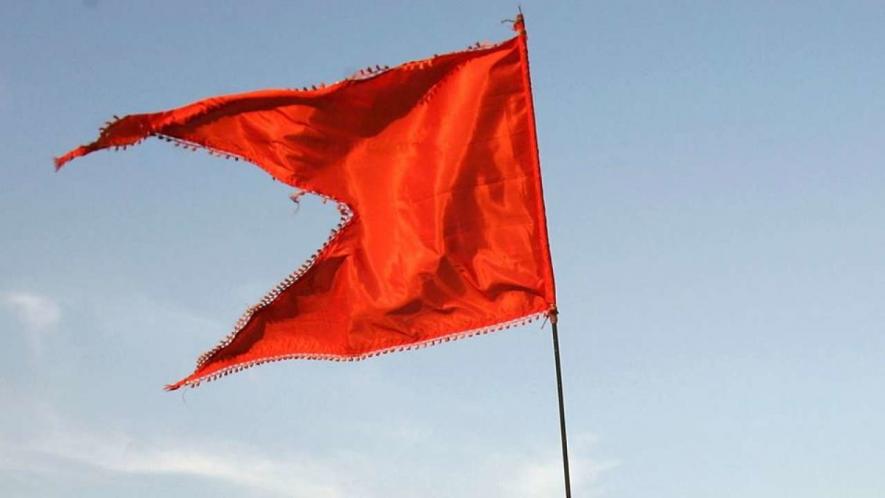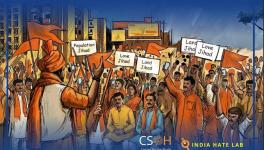Will India Finally Become a Hindu Rashtra?

The recent results in the Assembly elections have yet again signaled a setback to the expanding Hindutva agenda for the BJP/RSS combine. With the Rashtriya Swayamsevak Sangh (RSS), this cannot be merely seen as an electoral loss but brings into question the legitimacy of its long-term agenda of making India a Hindu Rashtra. When the Bharatiya Janata Party (BJP) looses elections, does it also mean the majority Hindus are also rejecting the agenda of self-representing India as a new age Hindu Rasthra?
The story might be more complicated than what the electoral reversals allow us to read. While a new militant imagination of Hinduism and an aggressive and an aggrieved Hindu has become the new common sense and holds sway as a more durable social hegemony, it is struggling to get reflected as electoral gains. Electoral results swing between a committed response to the social imagination of a robust Hindu Rasthra, but it also recedes when the economy does not do well. Other more pressing local concerns of the electorate do not make this social imagination either attractive or viable.
There is a growing tension between democracy and the illiberalism of Hindutva. The BJP/RSS combine is attempting to convert and merge the politics of gaining an electoral majority into a social majoritarianism. Till date, Gujarat alone has come close to realising this macabre utopia. It has very promising but mixed results in much of the Hindi heartland and a very distant potential in much of South and Eastern parts of India.
What we witnessed in the past four-and-half years of Narendra Modi’s rule was an experiment of extending the `Gujarat model` to the rest of India. Uttar Pradesh, especially after the murder of the police inspector by marauding mobs, and the chilling indifference of Chief Minister Yogi Adithyanath and shrill justification of prioritising the cow above the pending inquiry into the death of the policeman, comes close to how Gujarat was governed and how the social distance between religious communities became wider and enduring. It’s an intriguing contrast that the success of brand Hindutva in an industrialised state is being followed up by one of the most under-developed states in India.
The attempt to draw equivalence and project much of the Hindi heartland as a common ground of Hindutva has undoubtedly failed to take off, but has made a sordid beginning. The incidents in Dadri and the beheading and burning alive of a Muslim from UP in Rajasthan were events manufactured to produce a new common imagination of a Hindutva North, setting aside the earlier comparisons across the axis of developmental index of being BIMARU states. A state like Madhya Pradesh has a massive social presence of the RSS though it has a Muslim population of only 4%. The recent overtures of the Congress to shift to a more blatant Hindutva agenda in such a state, is a clear symbol of the social hegemony of Hindutva, though the BJP lost the elections on an agrarian issue, reflecting the possible separation of the social and the political.
How and when does such a separation work itself remains a significant issue in understanding the distance the Right has to travel in finally declaring India a full-fledged Hindu Rashtra. Are the vagaries of electoral fortunes a stumbling block that the Right has to overcome in order to achieve the final goal? If so, what can they do about it? As of now, it looks like except for a wholesome amendment of the Constitution and a forced change from above looks like the only plausible strategy they have, in order to bring the electoral/political and the social dimensions of the Hindutva brand of politics together.
Much of the North has a history still marked by the memories of Partition. The early inroads made by the Hindu Mahasabha and Arya Samaj in the North attempted to combine an agenda of social reform within Hinduism with an anti-Muslim rhetoric. Madan Mohan Malviya is a good example of how he put the agenda of fighting social prejudice against untouchability as a precondition if Hindus were to remain safe in the face of an expansionist Islam. He, therefore, also established the Banaras Hindu University in order to teach ancient Hindu philosophy and provide Hindu youth with modern education. This early experiment at social reform got scuttled with the ascendance of RSS and the eventual decline of the Hindu Mahasabha. RSS became the only force that began operations on the social front, working its way in the realm of family, religion and education.
There were no other major social experiments and all counter-narratives took only a political shape, including Dalit politics with the rise of the Bahujan Samaj Party (BSP). In spite of articulating the idea of a Bahujan, BSP hardly made any social experiments on how to overcome social prejudices between Dalits and the Other Backward Classes or Hindus and Muslims. Dalit politics itself had very little social content other than gaining political power and enact enabling social legislations.
Added to this was the abject collapse of institutions of higher education, lack of industrialisation and eventual death of social imagination. All of these remained and worked as enabling factors for mobilising different social constituencies around Hindutva politics. The proximity of the North in claiming to represent the nation led to an exalted idea of nationalism, even as it kept steadily declining on economic and social fronts.
Much in contrast to this was the story of the South. The region did not have the burden of Partition, and it became the site of social reform and spearheaded the anti-Brahmin movement. It included the likes of Basava in Karnataka, and Narayan Guru in Kerala. Later, social reform was continued by Periyar in Tamil Nadu. Social reform not only remained distinct from the political but influenced it in positive ways. Many parts of the South also had independent Dalit movements raising various social questions of stigma, access to education, even as it failed to take a distinct political shape in the form of an independent Dalit political party. In spite of an independent Dalit movement, BSP never took off as a viable political force in the South.
Apart from the Dalit movement, many states of the South continued to have the presence of various Left parties, both in mobilising the class question and making their electoral presence. In fact, the Left in India succeeded in those parts where it was preceded by powerful social reform movements, even if the Left itself failed to articulate social issues. Left parties were the political expression of social change.
In spite of a sizeable presence of Muslim population in states like Telangana and Kerala, the Hindutva brand of politics never gained any respectable presence. In spite of the presence of the RSS in states like Karnataka, its brand of aggressive Hindu militancy was limited and contained in pockets, such as coastal Karnataka. Recent campaigns by Yogi Adityanath in Telangana raising demands to change the name of Hyderabad and Karimnagar, and driving out the Owaisis only made for good optics at best, and slapstick entertainment, at worst.
The debate in much of the South continues to be around welfare, including employment, accessible health and educational facilities, agrarian distress, and minimum wages, among others. There is a strong connection between displacement of social welfare and the rise of Hindutva. In fact, the terminal decline of Congress began with its dismantling of the developmental-welfare state on the economic front, and hanging on to secularism on the social front, allowing the BJP/RSS to re-represent secularism as appeasement.
Undoubtedly, the RSS is continuously re-working its strategy to the needs of regional specificities. It will continue to find new entry points to breach the citadel of the South, with the Sabrimala issue being the latest salvo that did not yield the desired electoral results and may not in 2019. The tension between Hindutva`s Gangetic Barbarism and South`s anti-Brahmanism will remain one of the major hurdles that the RSS needs to breach to achieve its macabre utopia of a Hindu Rashtra.
Meanwhile, the Left-progressive forces need to identify the limits of their secular-constitutional discourse, and mere minoritisation of Muslims is not a guarantee against fresh inroads that the Right is set to make. Mere electoral defeats of the BJP are not the correct signposts of the extent of its social hegemony. One way to stall the spread of Hindutva brand of politics is actually to take the question beyond Hindu-Muslim and the secular-communal rhetoric. Rebuilding a robust welfare state, with focus on free and compulsory common school kind of education system, and a wider engagement of the gender issue could well be the entry points to bring back the social question in the North. Along with that nuetralisation of Hindu mobilisation by providing for different social and political spaces for Hindu identity could well stall it from taking a more majoritarian turn, rather than disallowing it the space it is demanding for itself. There has to also be a more open and unhitched debate on the limitations of Muslim politics in India. To merely assume that an average Muslim is not as communal as an average Hindu is only displacing the question of religious polarisation. What could be the modality of such a debate without further ostracising the Muslims is itself a complex issue that needs some immediate attention.
Finally, we need to go back to the question of the self that got lost in the way modern politics encroached on legitimate issues of spirituality. Gandhi was perhaps the best representative of this at the turn of an independent India. His elaborate symbolism was one of the finest experiments of foregrounding the question of self, outside, not independent, of the question of the political and the social. Ambedkar, who began as a high-modernist, towards the closing years of his public life, moved into the realm of questions of the self in invoking Buddhism in a more philosophical sense. What constitutes a self that can rise above immediate identity to be able engage with questions of justice. In the times we are living, what kind of symbolism and socio-political language can the question of the self be brought back? Only in such a multivalent mode can we suitably resist India from becoming a Hindu Rashtra.
(The writer is Associate Professor, Jawaharlal Nehru University, Delhi. He just published his book, India after Modi: Populism and the Right (Bloomsbury, 2018). The views expressed are personal.)
Get the latest reports & analysis with people's perspective on Protests, movements & deep analytical videos, discussions of the current affairs in your Telegram app. Subscribe to NewsClick's Telegram channel & get Real-Time updates on stories, as they get published on our website.
























